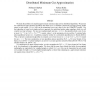Free Online Productivity Tools
i2Speak
i2Symbol
i2OCR
iTex2Img
iWeb2Print
iWeb2Shot
i2Type
iPdf2Split
iPdf2Merge
i2Bopomofo
i2Arabic
i2Style
i2Image
i2PDF
iLatex2Rtf
Sci2ools
183
click to vote
WDAG
2013
Springer
2013
Springer
Distributed Minimum Cut Approximation
We study the problem of computing approximate minimum edge cuts by distributed algorithms. We present two randomized approximation algorithms that both run in a standard synchronous message passing model where in each round, O(log n) bits can be transmitted over every edge (a.k.a. the CONGEST model). The first algorithm is based on a simple and new approach for analyzing random edge sampling, which we call random layering technique. For any any weighted graph and any ∈ (0, 1), the algorithm finds a cut of size at most O( −1 λ) in O(D) + ˜O(n1/2+ ) rounds, where λ is the minimum-cut size and the ˜O-notation hides poly-logarithmic factors in n. In addition, using the outline of a centralized algorithm due to Matula [SODA ’93], we present a randomized algorithm to compute a cut of size at most (2 + )λ in ˜O((D + √ n)/ 5 ) rounds for any > 0. The time complexities of our algorithms almost match the ˜Ω(D + √ n) lower bound of Das Sarma et al. [STOC ’11], thus lead...
Algorithms | WDAG 2013 |
| Added | 28 Apr 2014 |
| Updated | 28 Apr 2014 |
| Type | Journal |
| Year | 2013 |
| Where | WDAG |
| Authors | Mohsen Ghaffari, Fabian Kuhn |
Comments (0)

